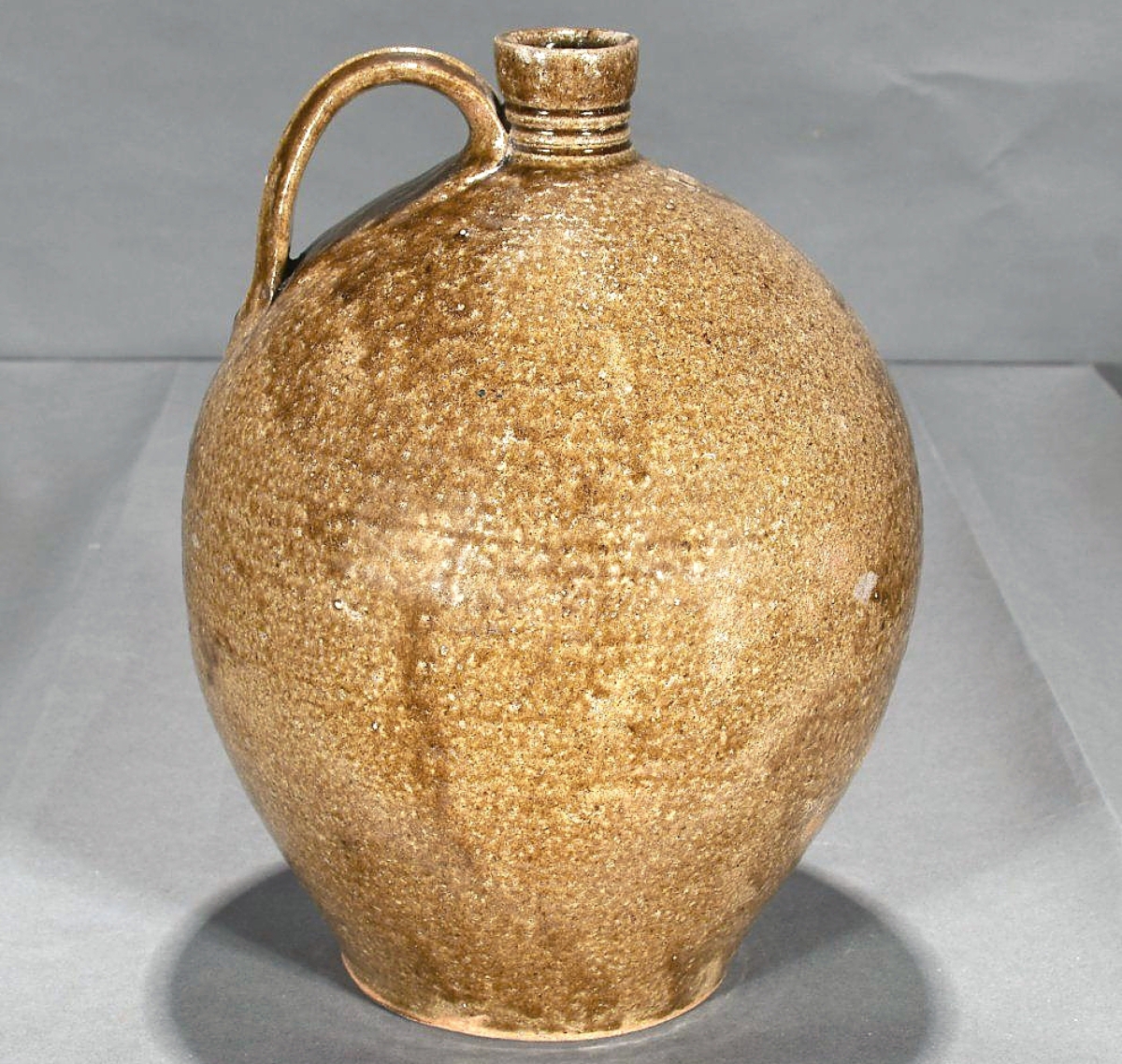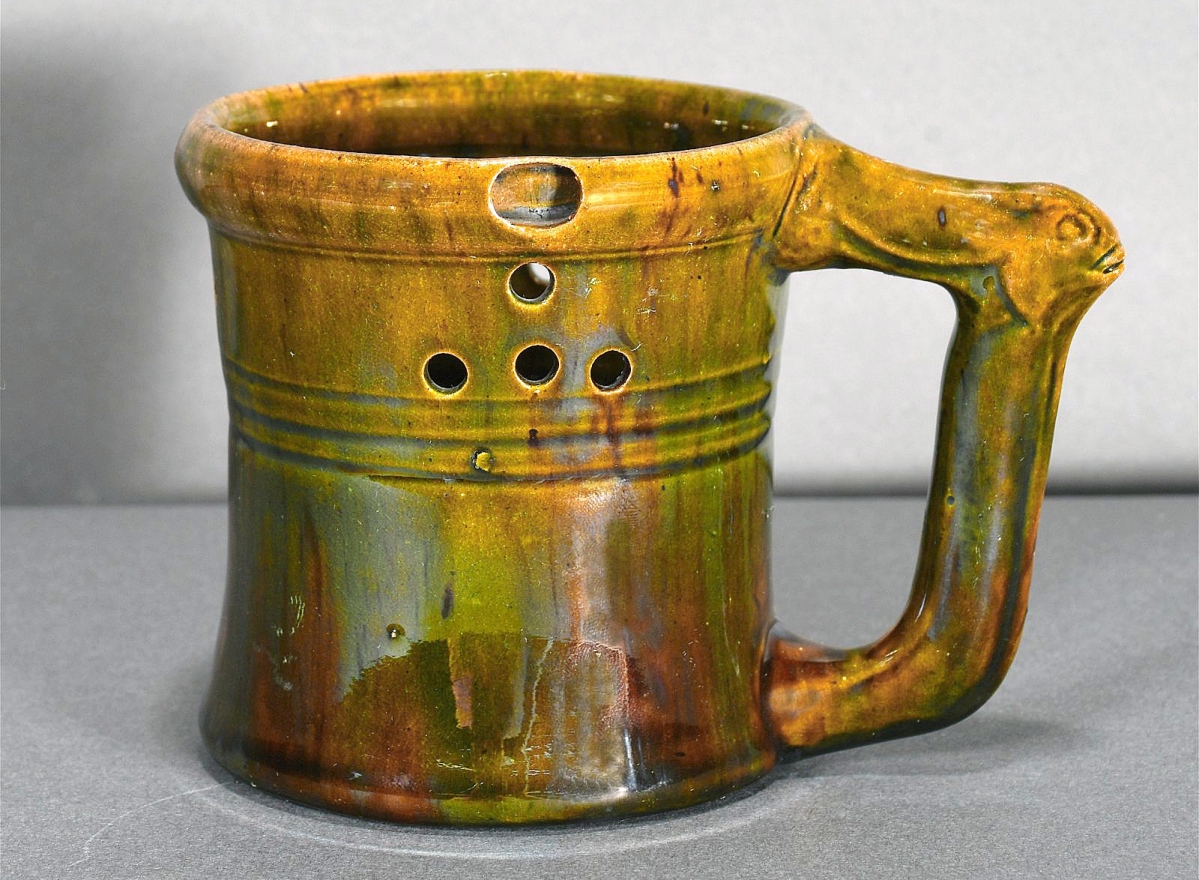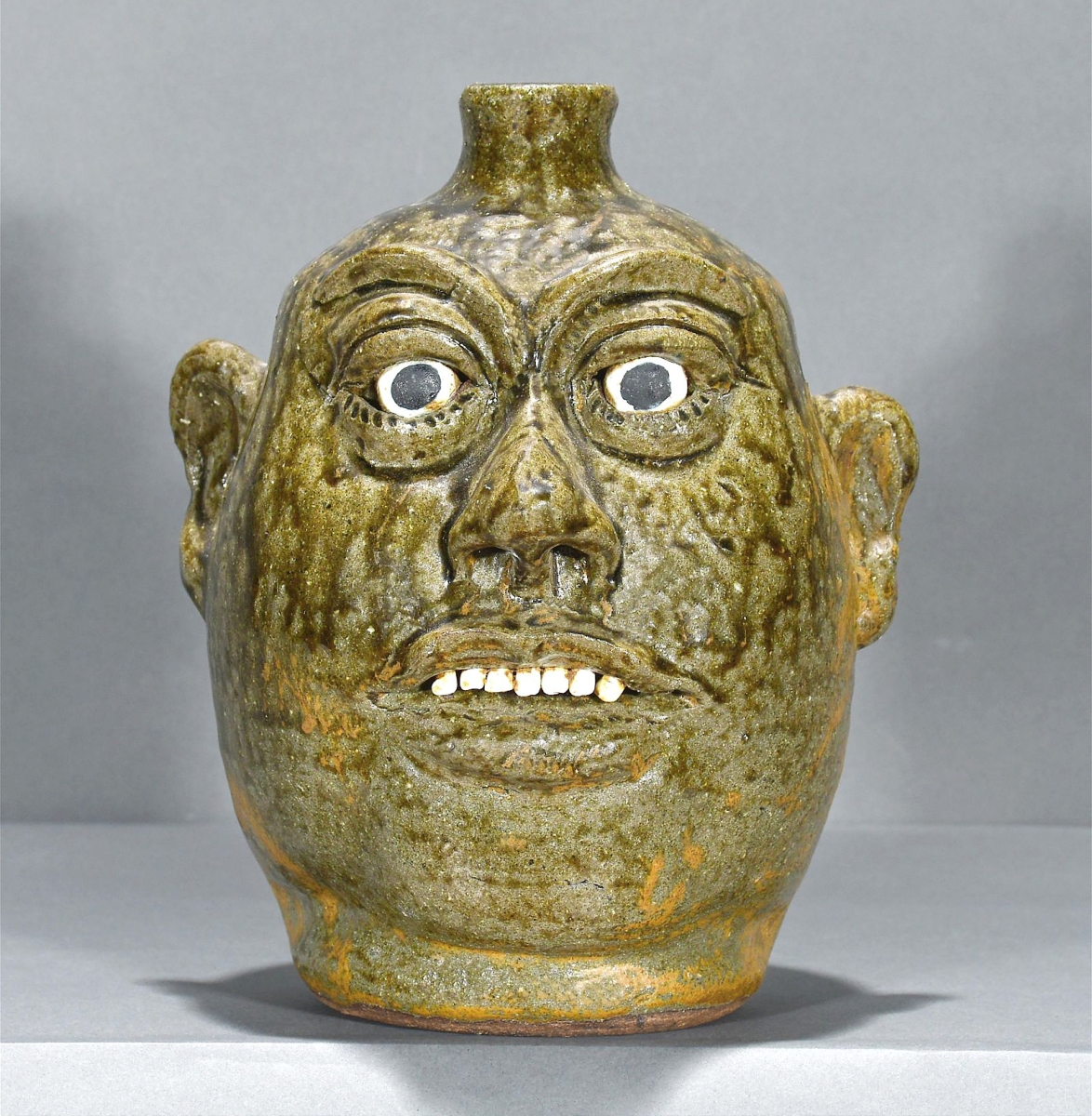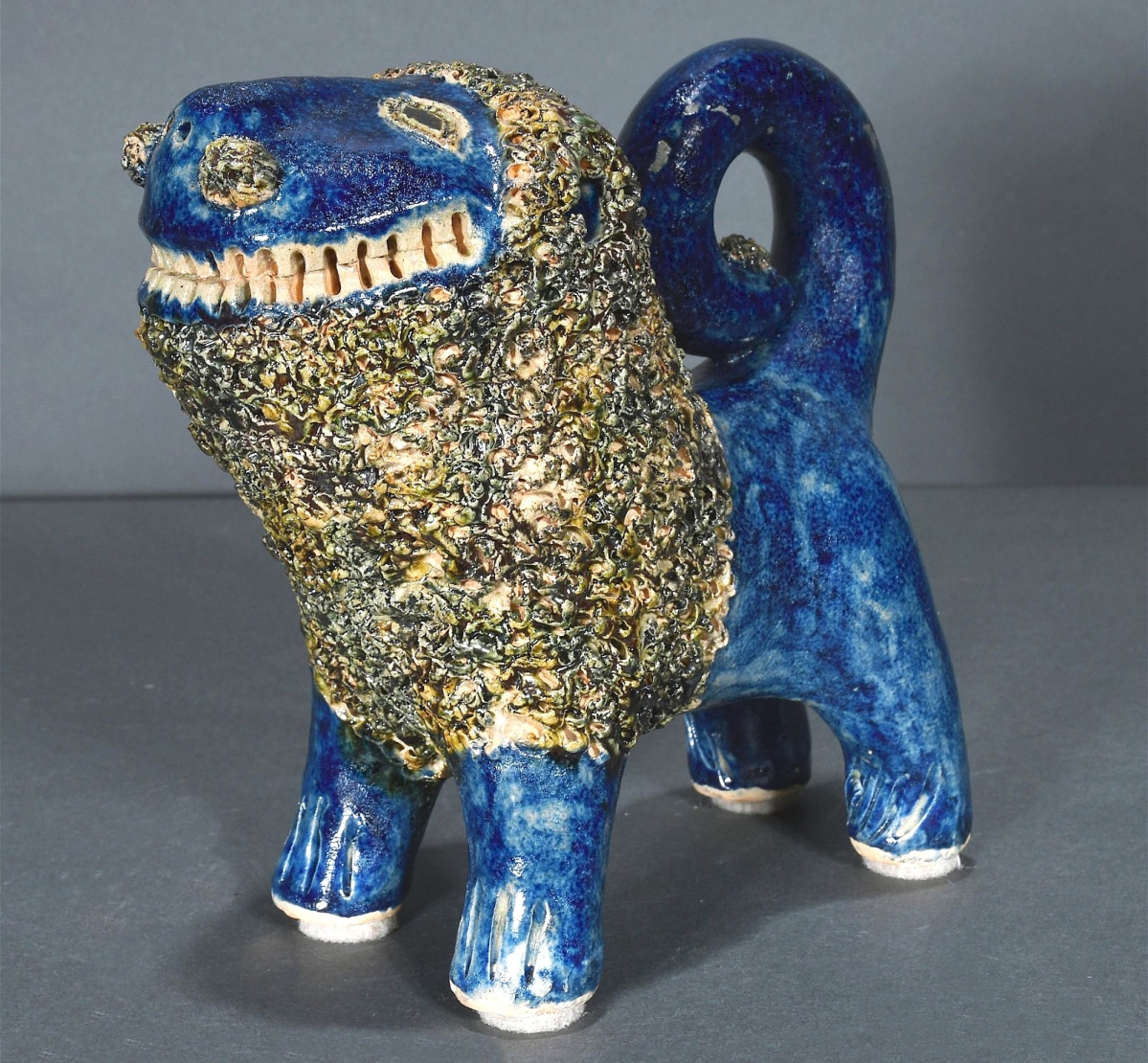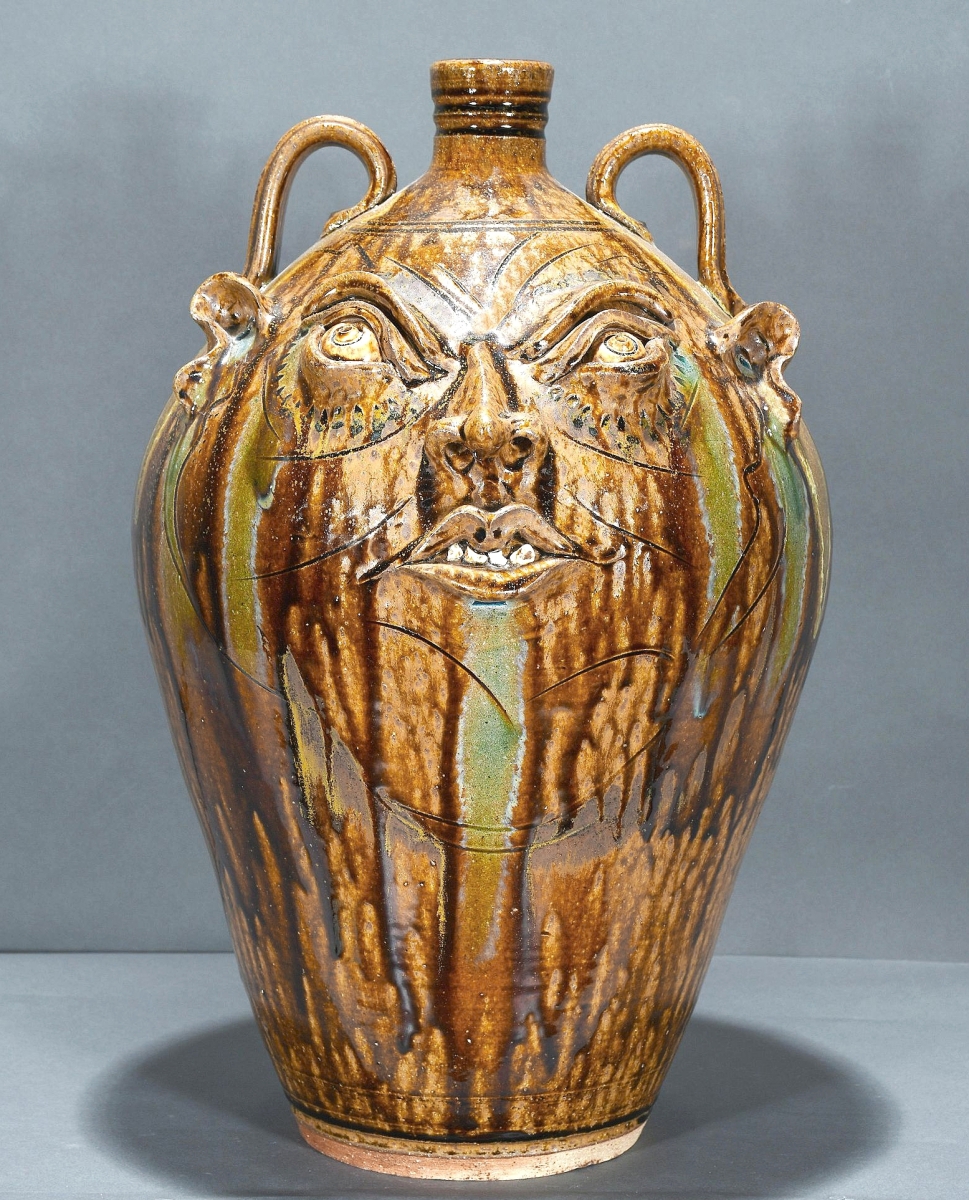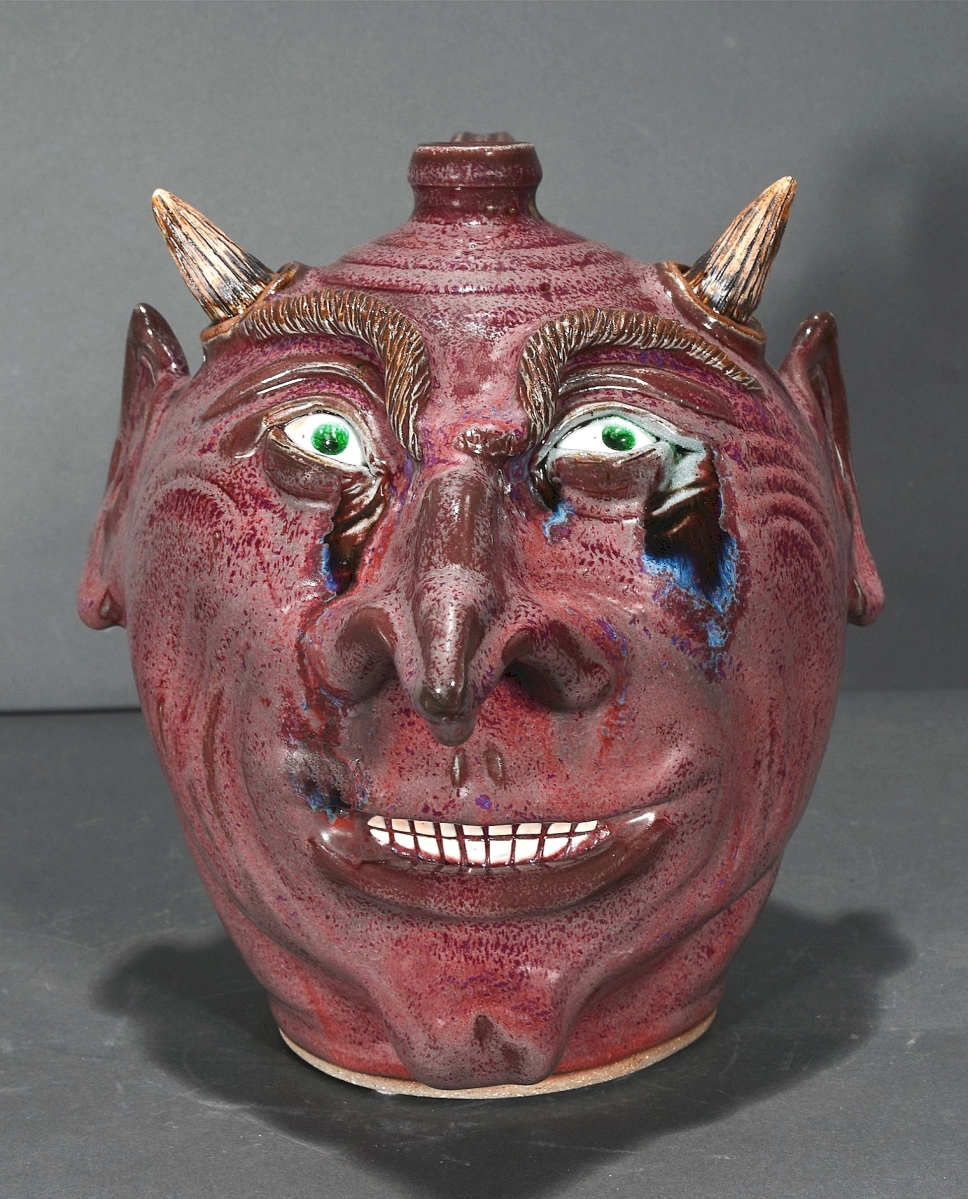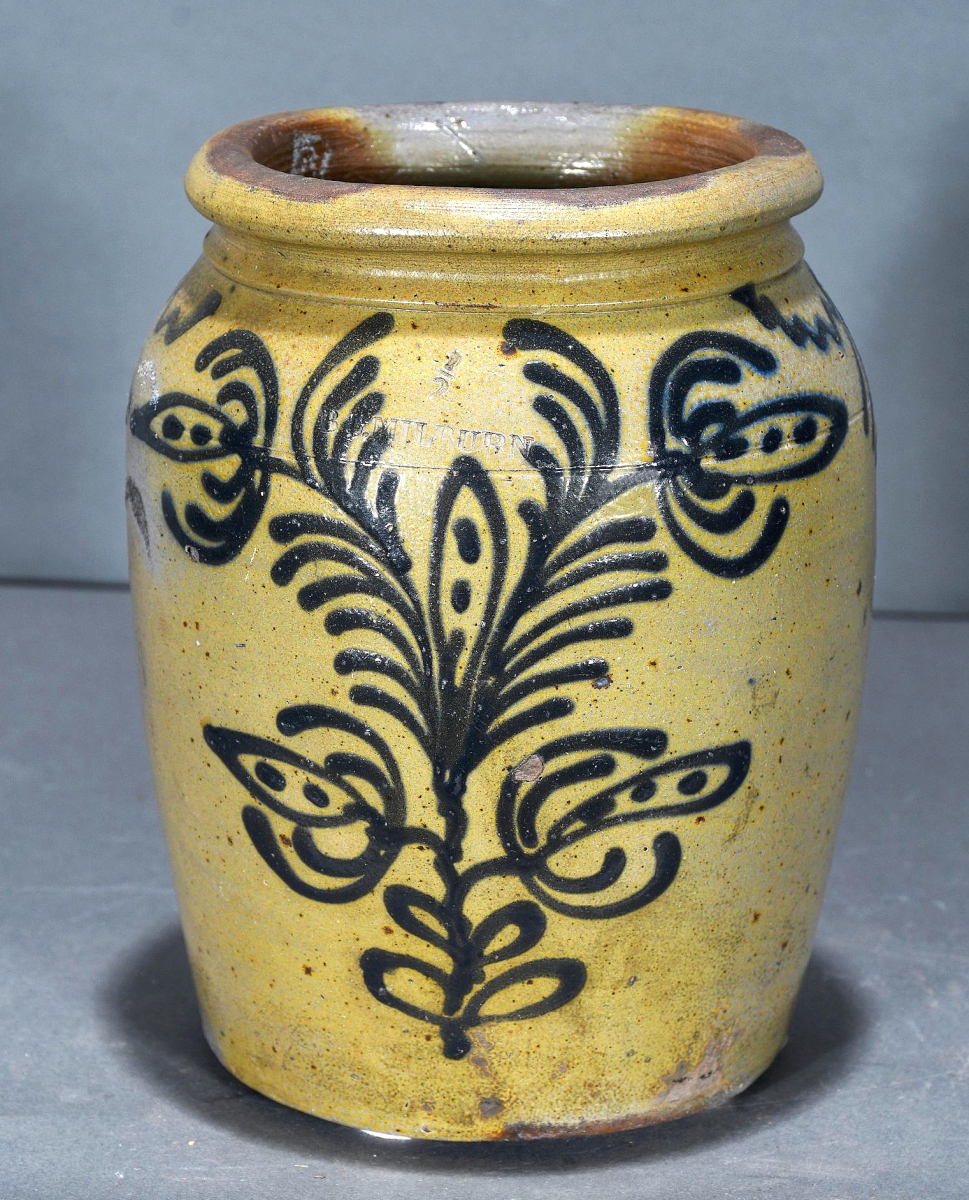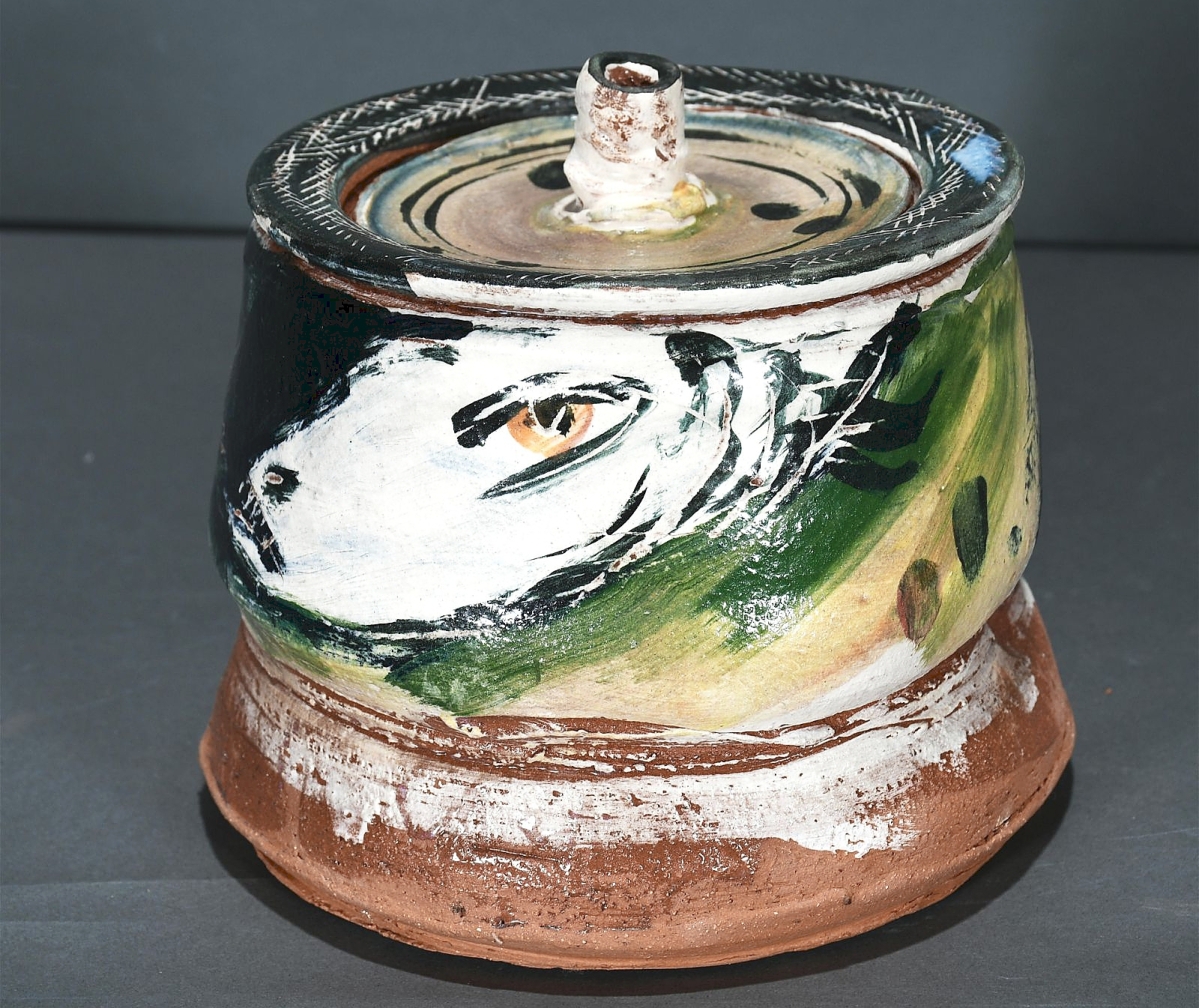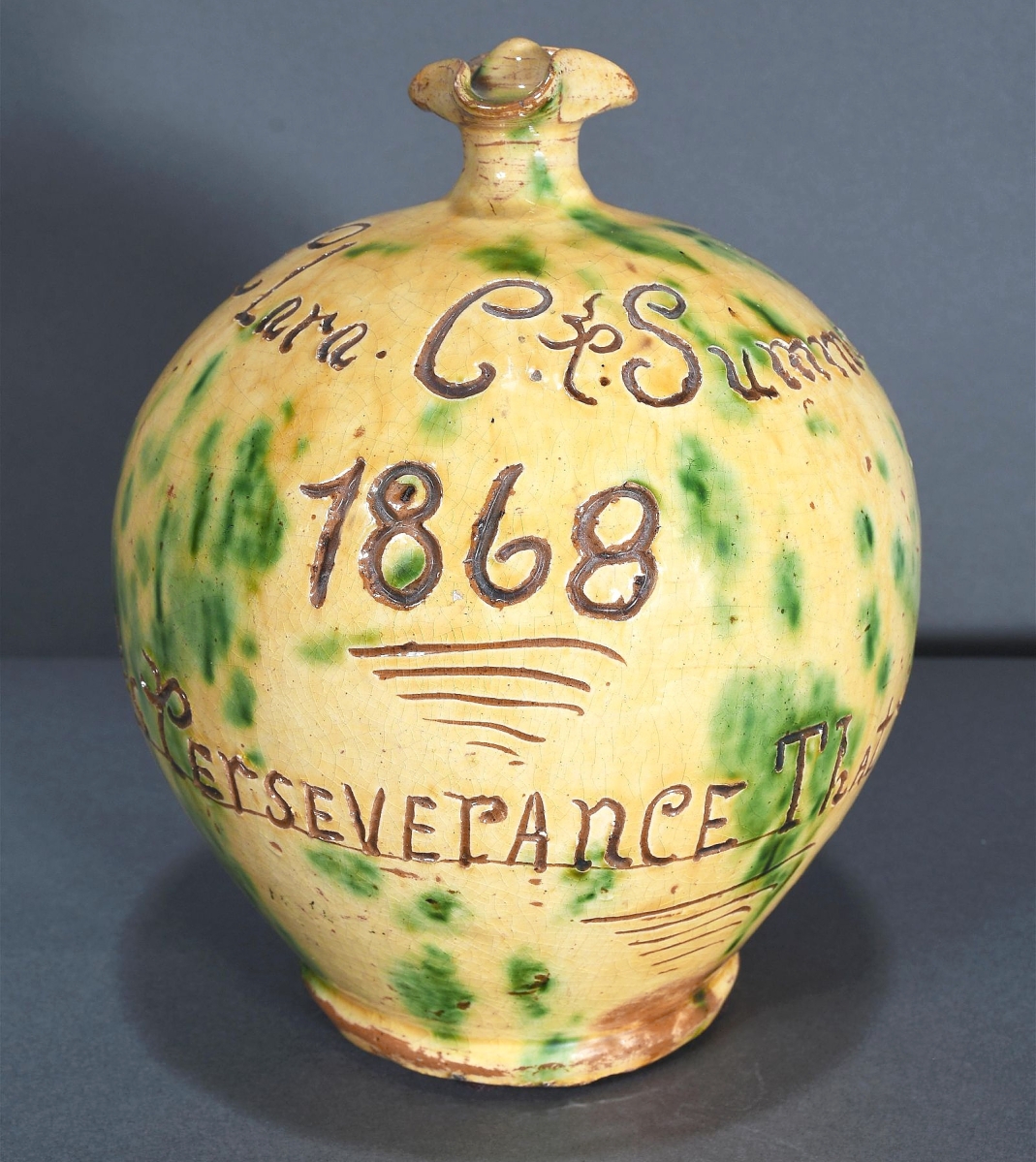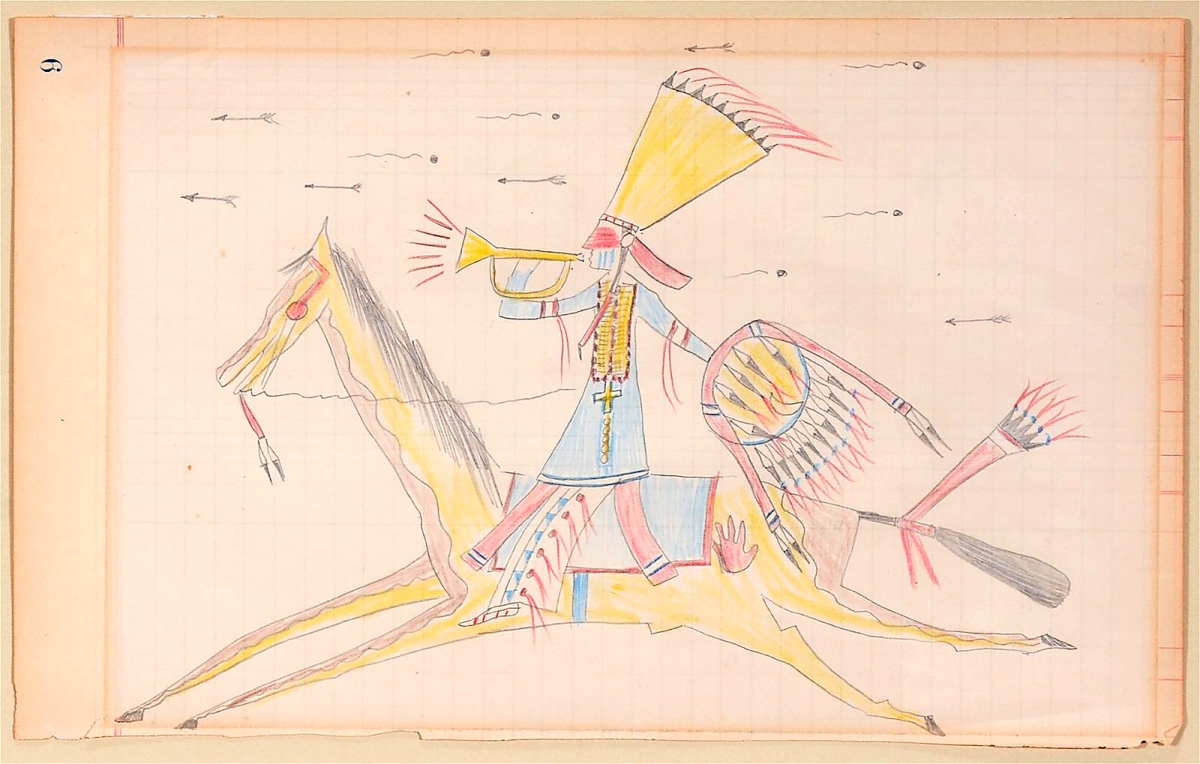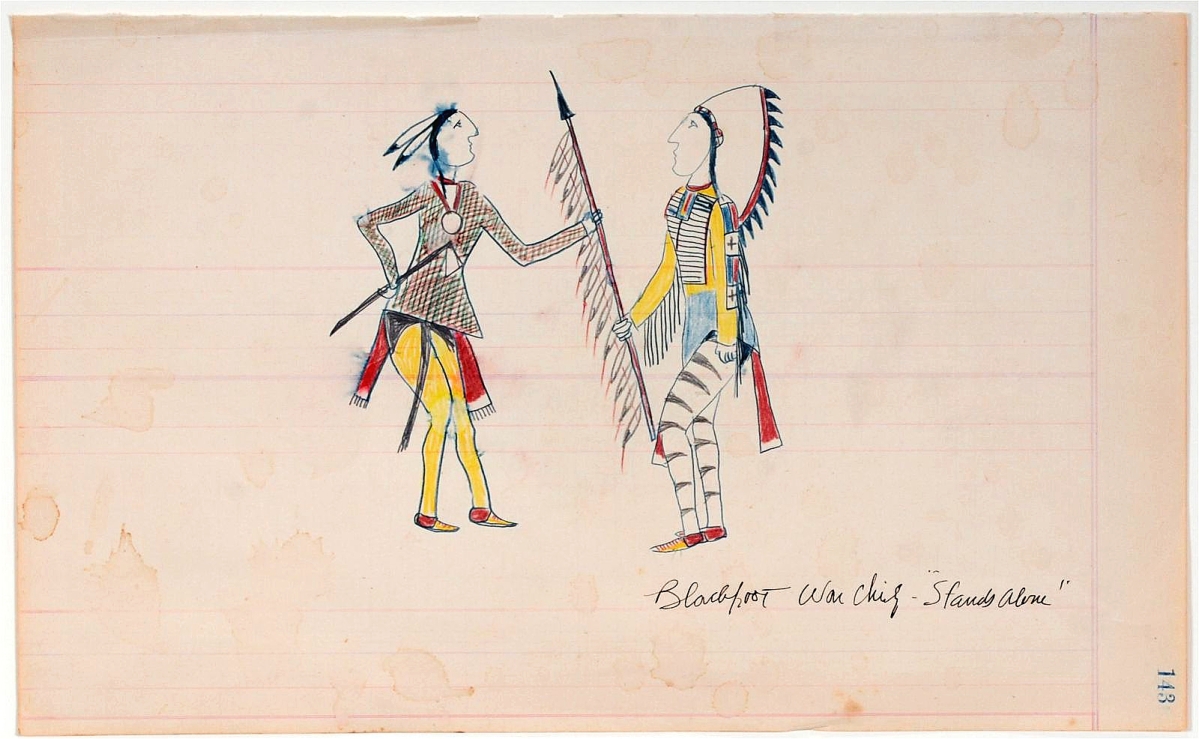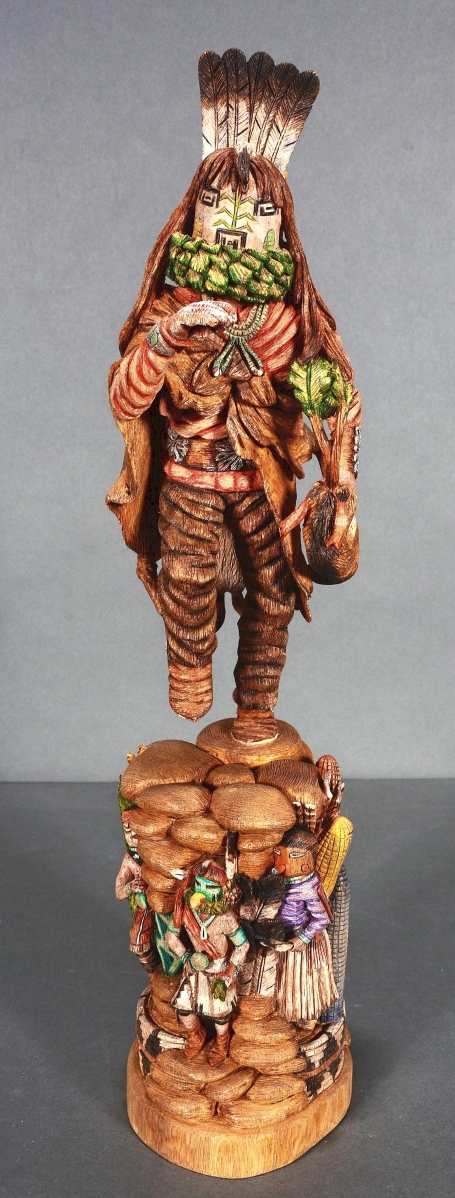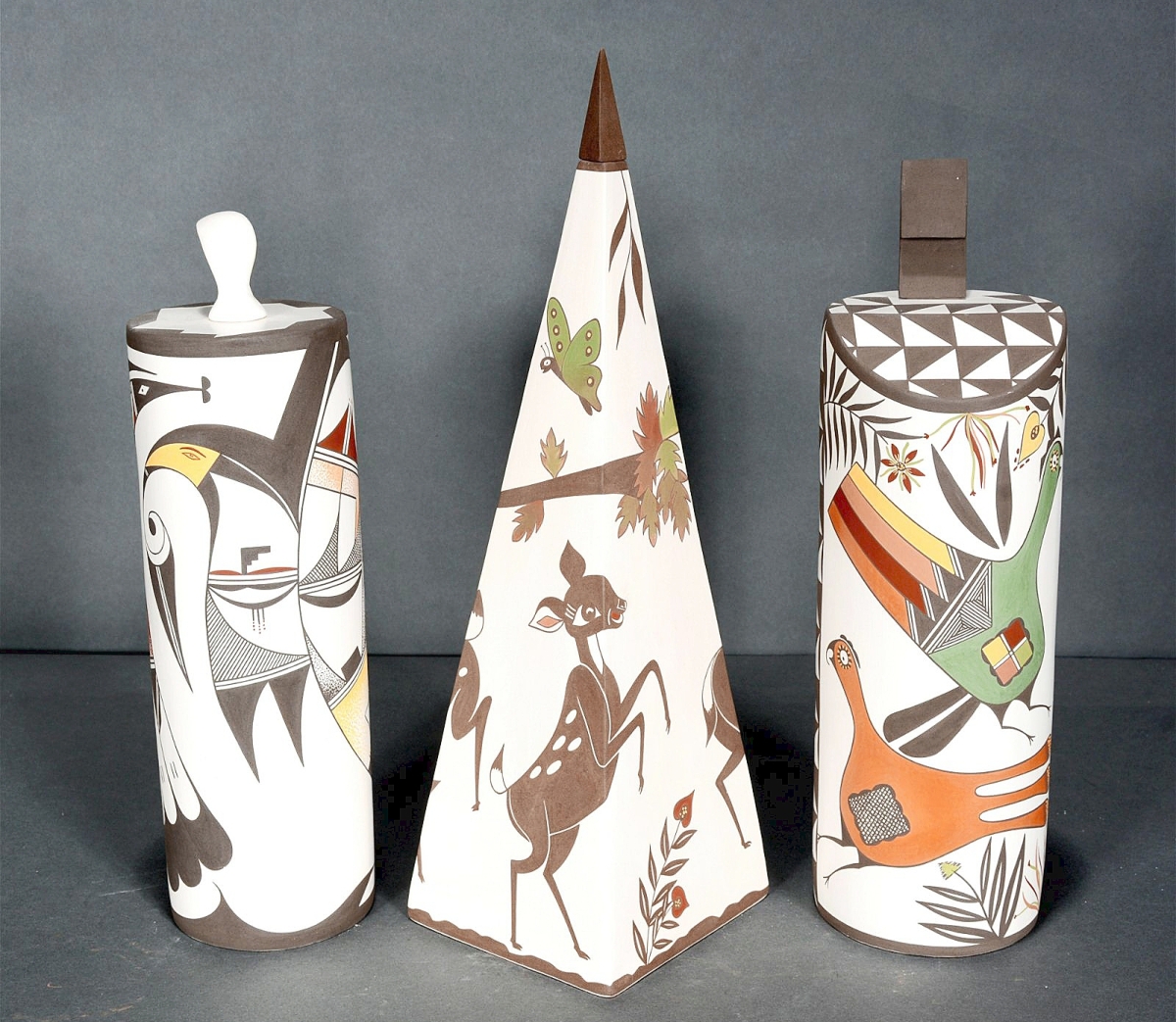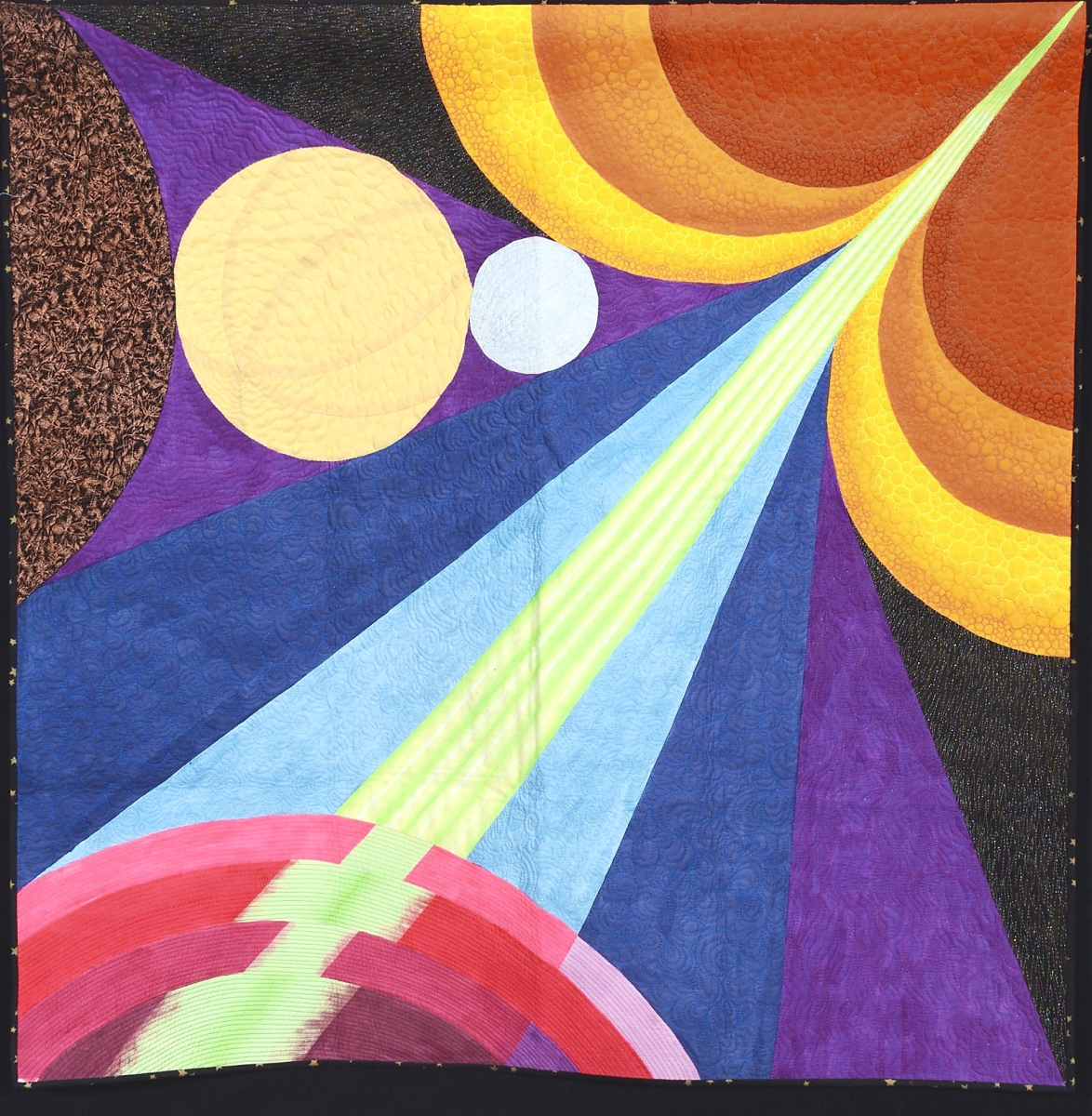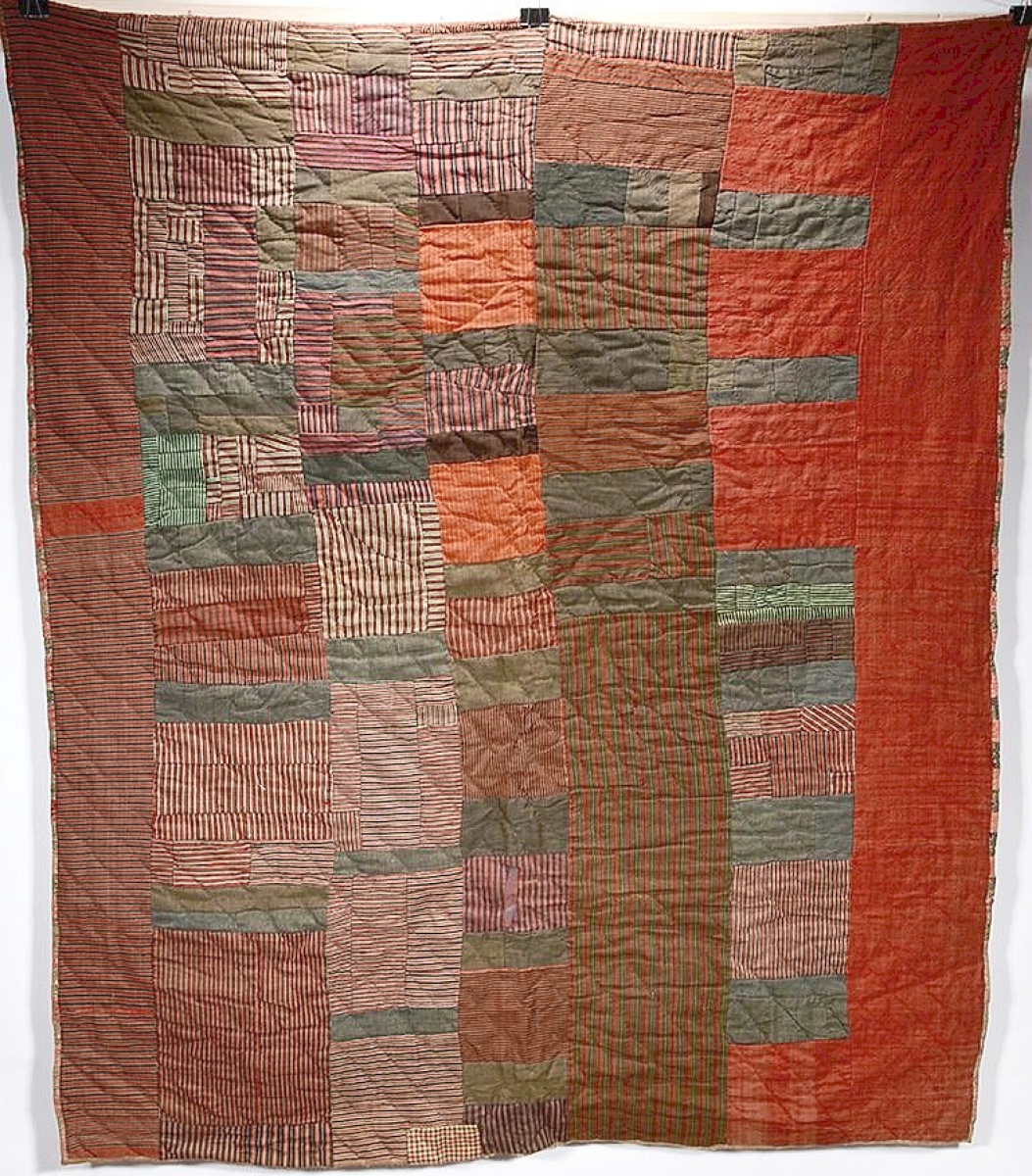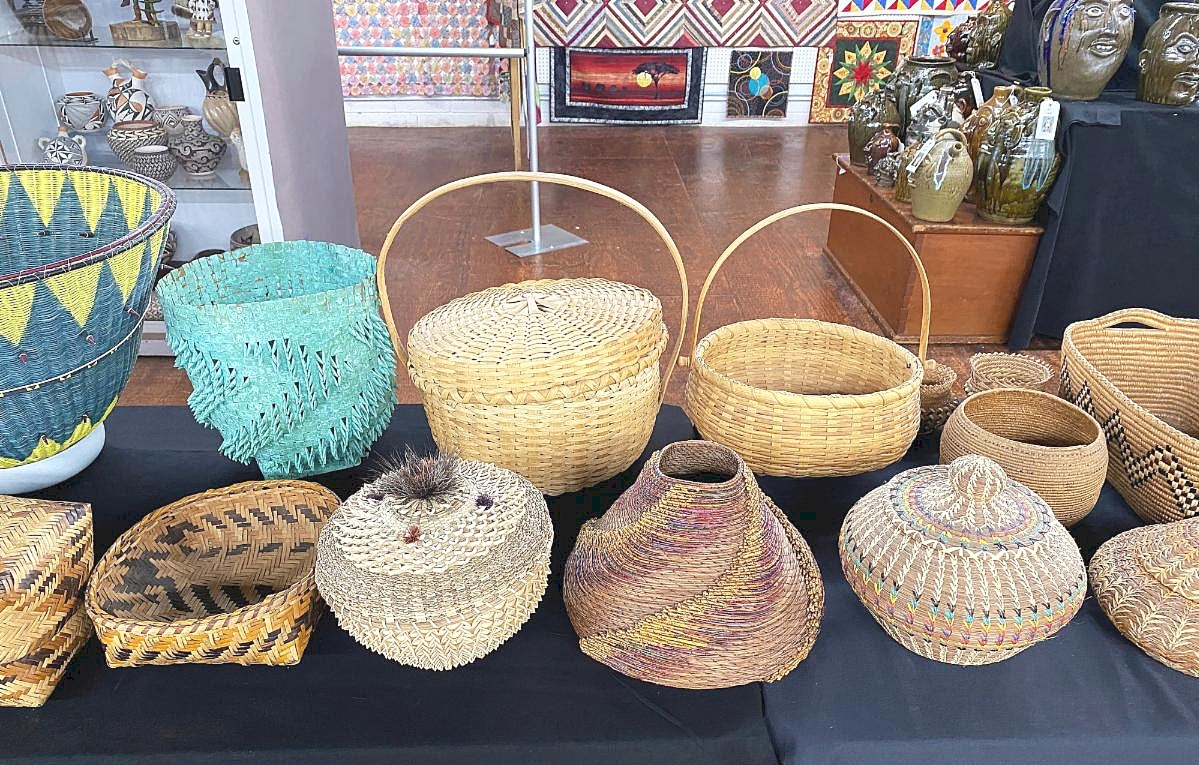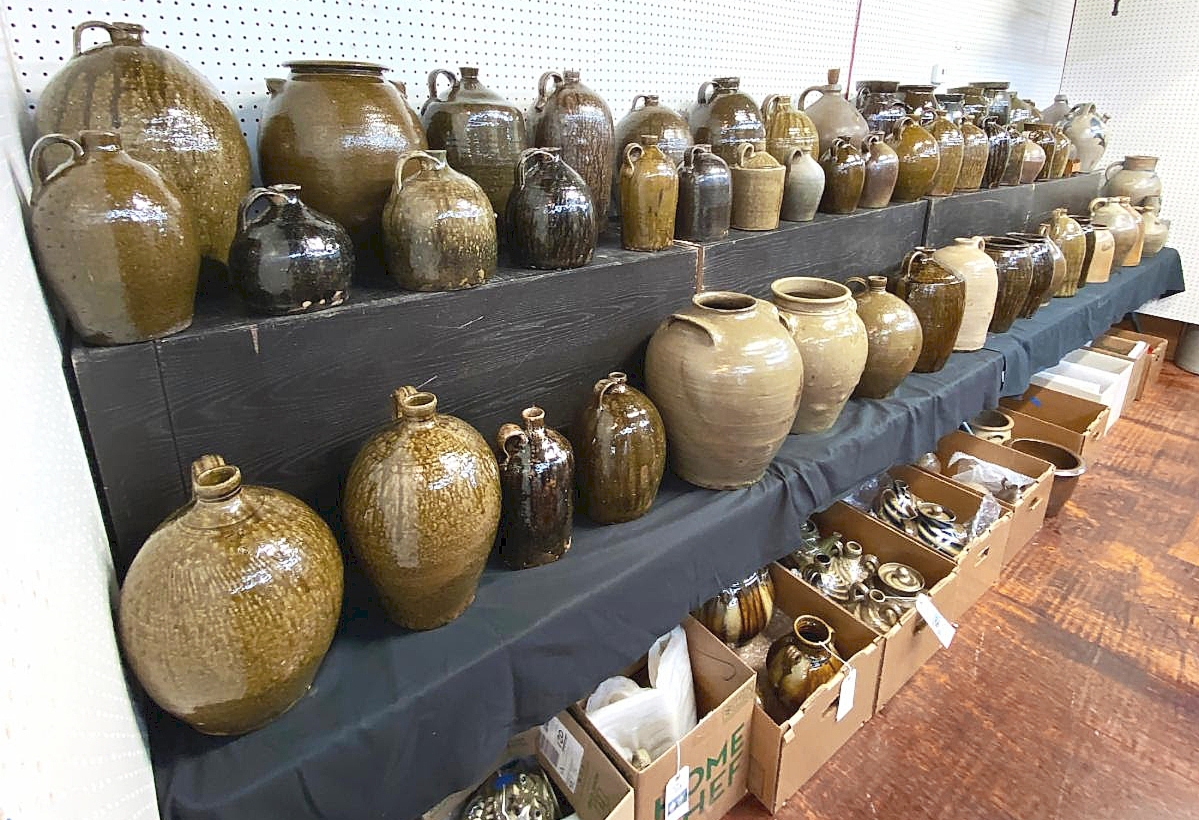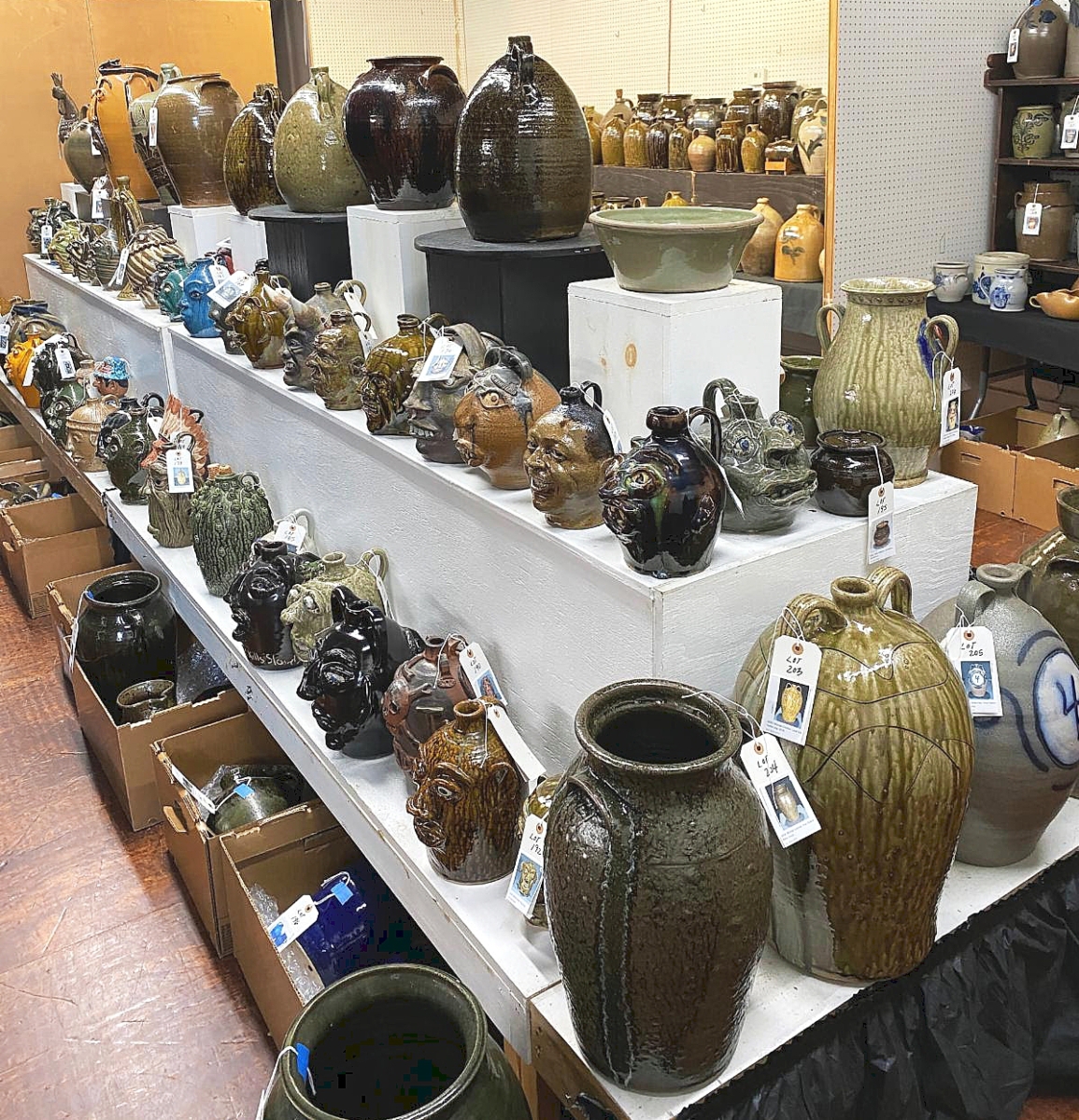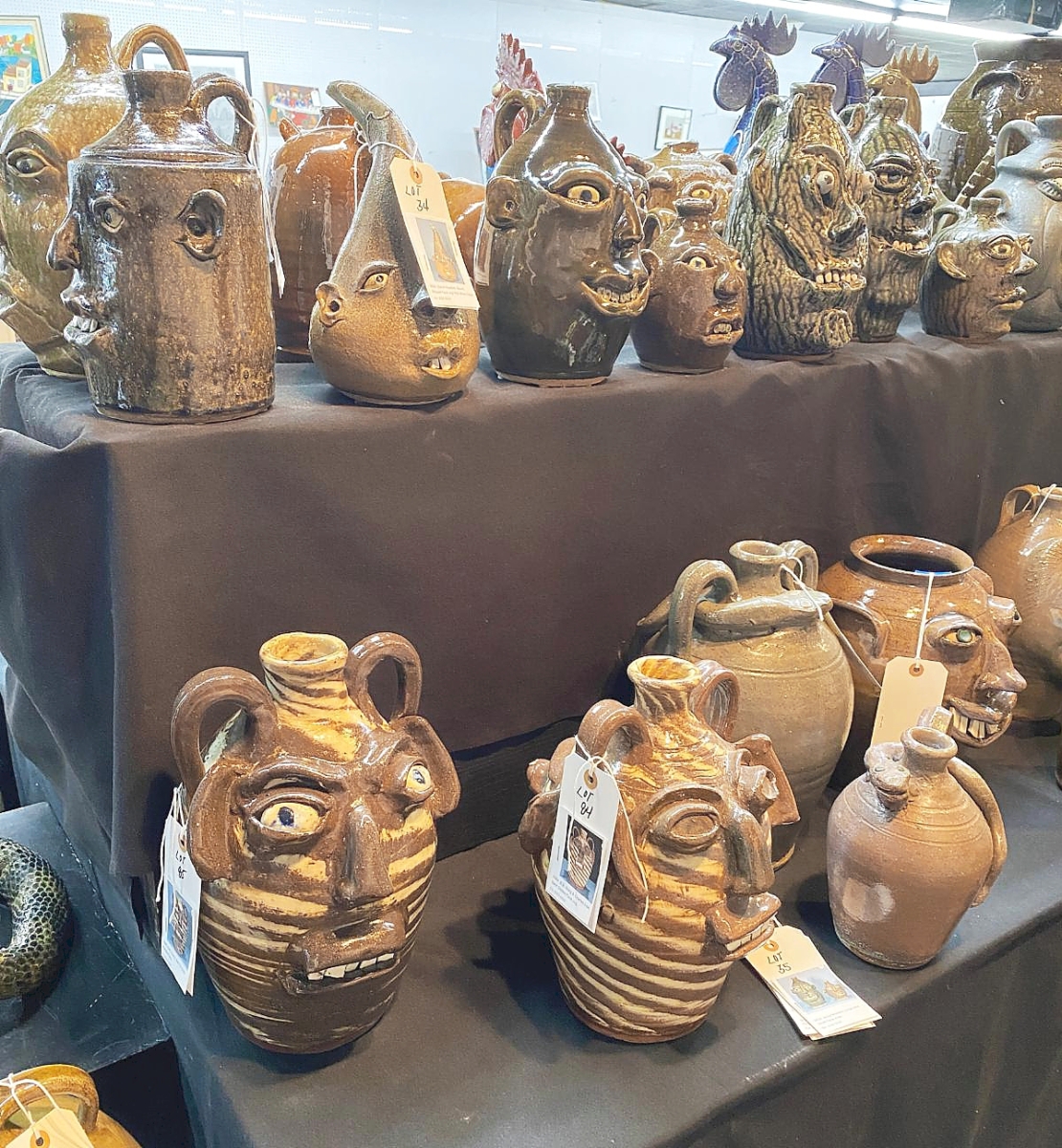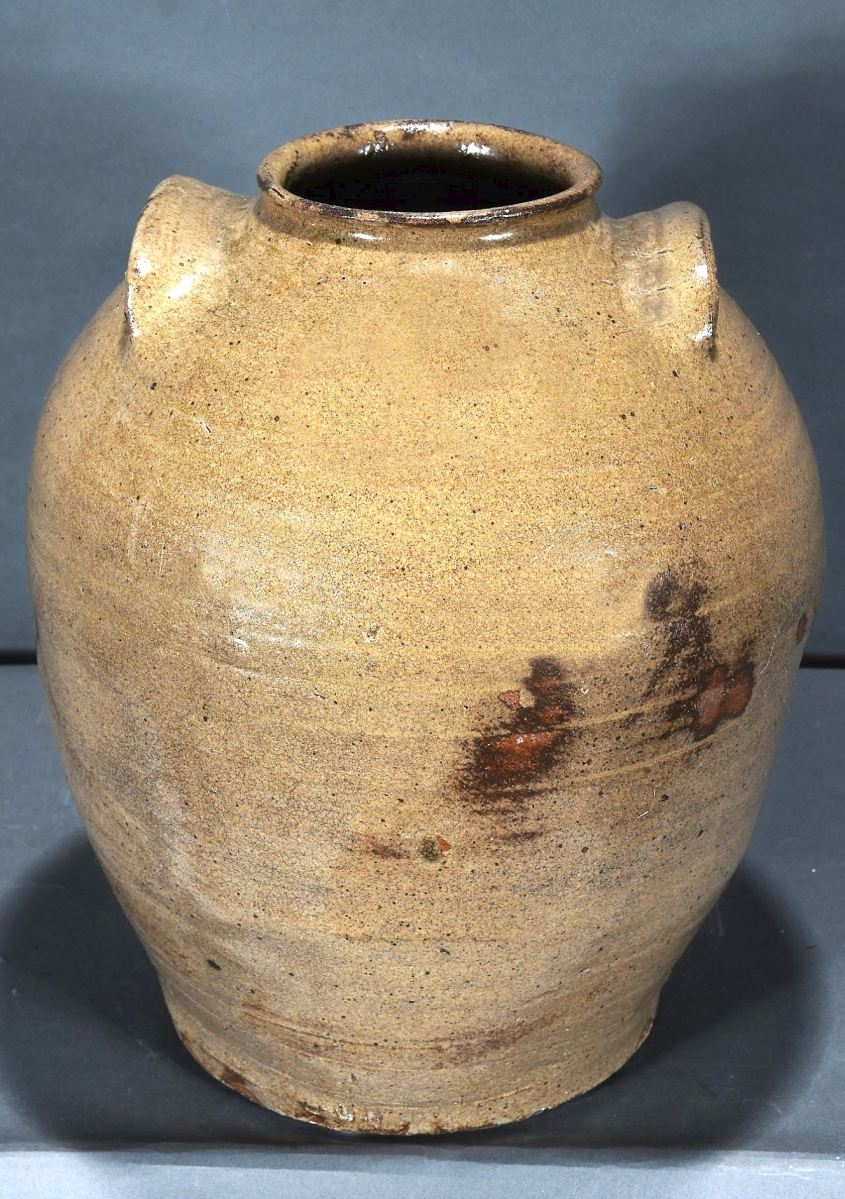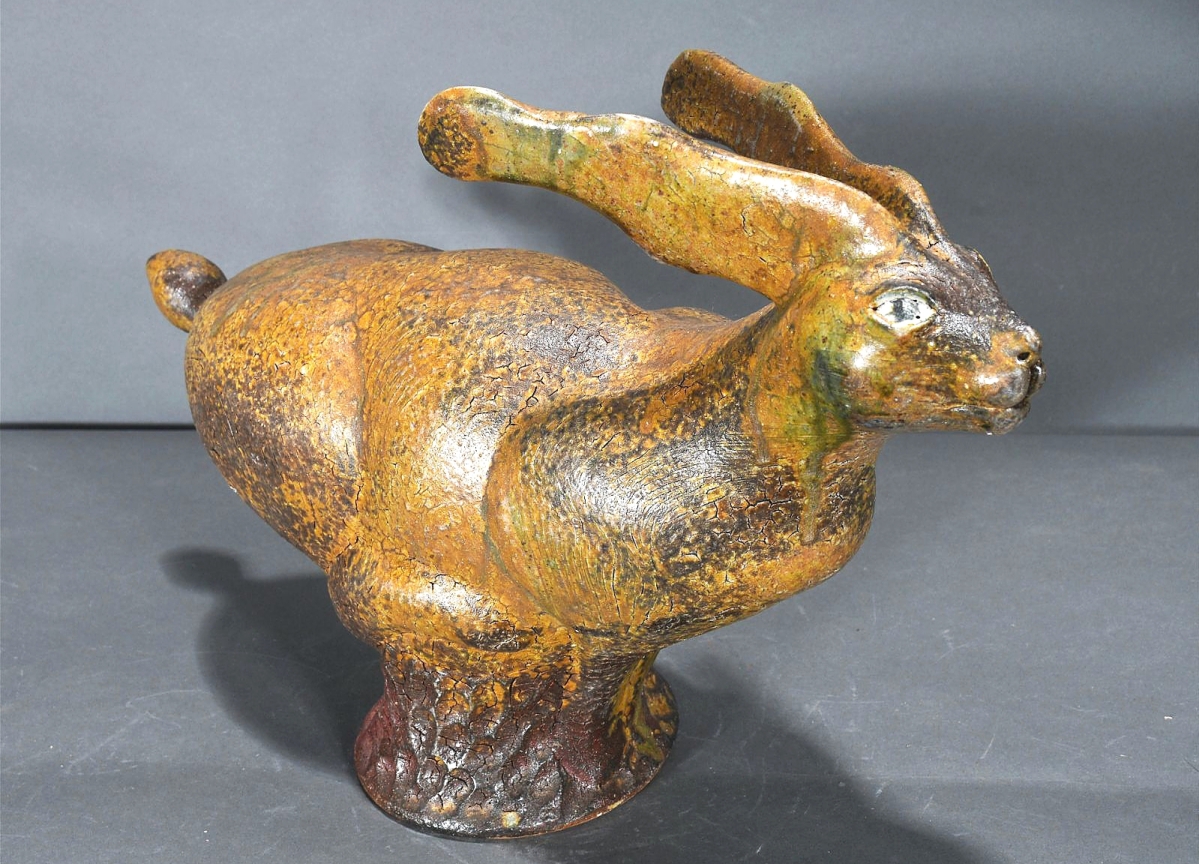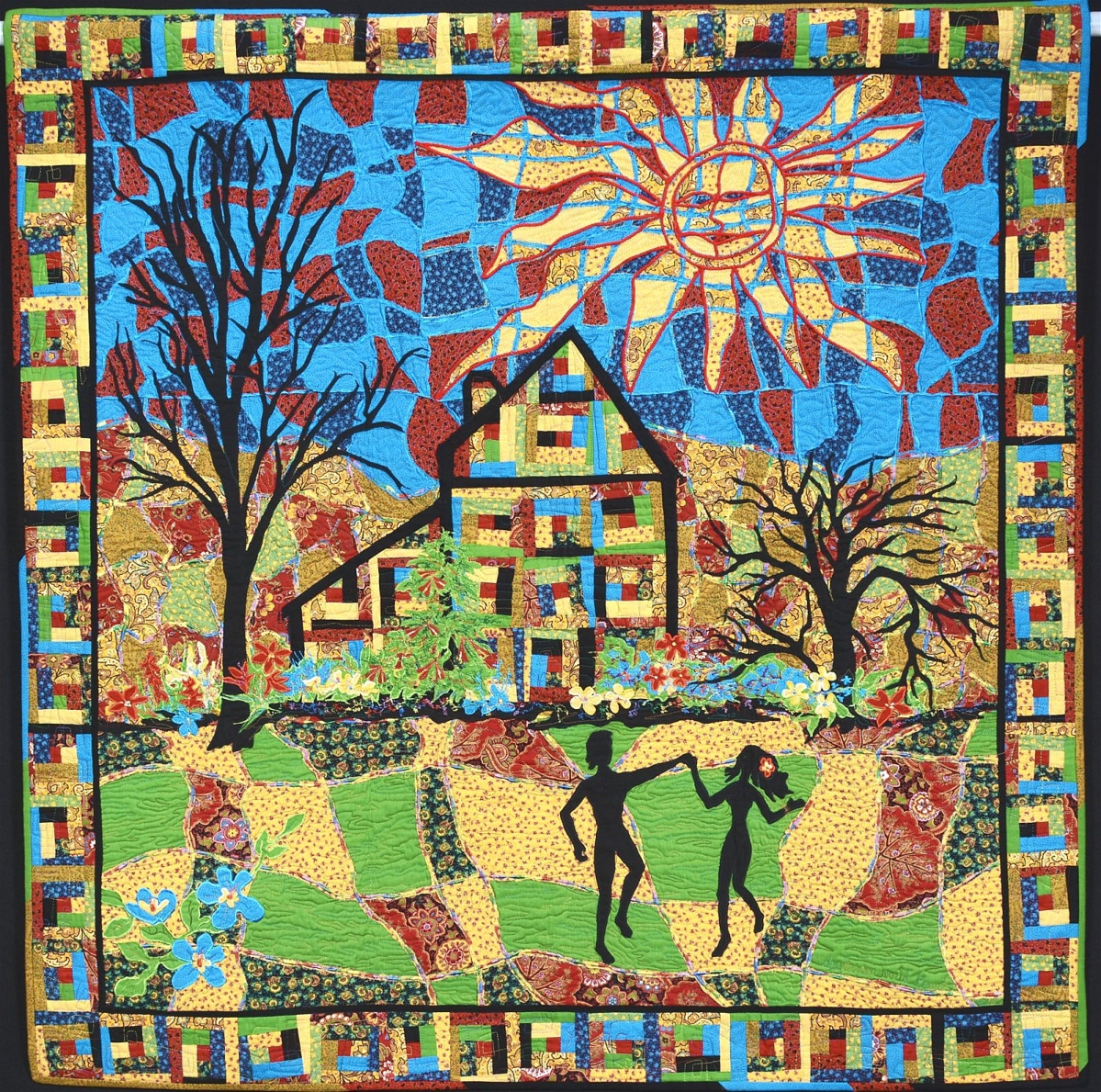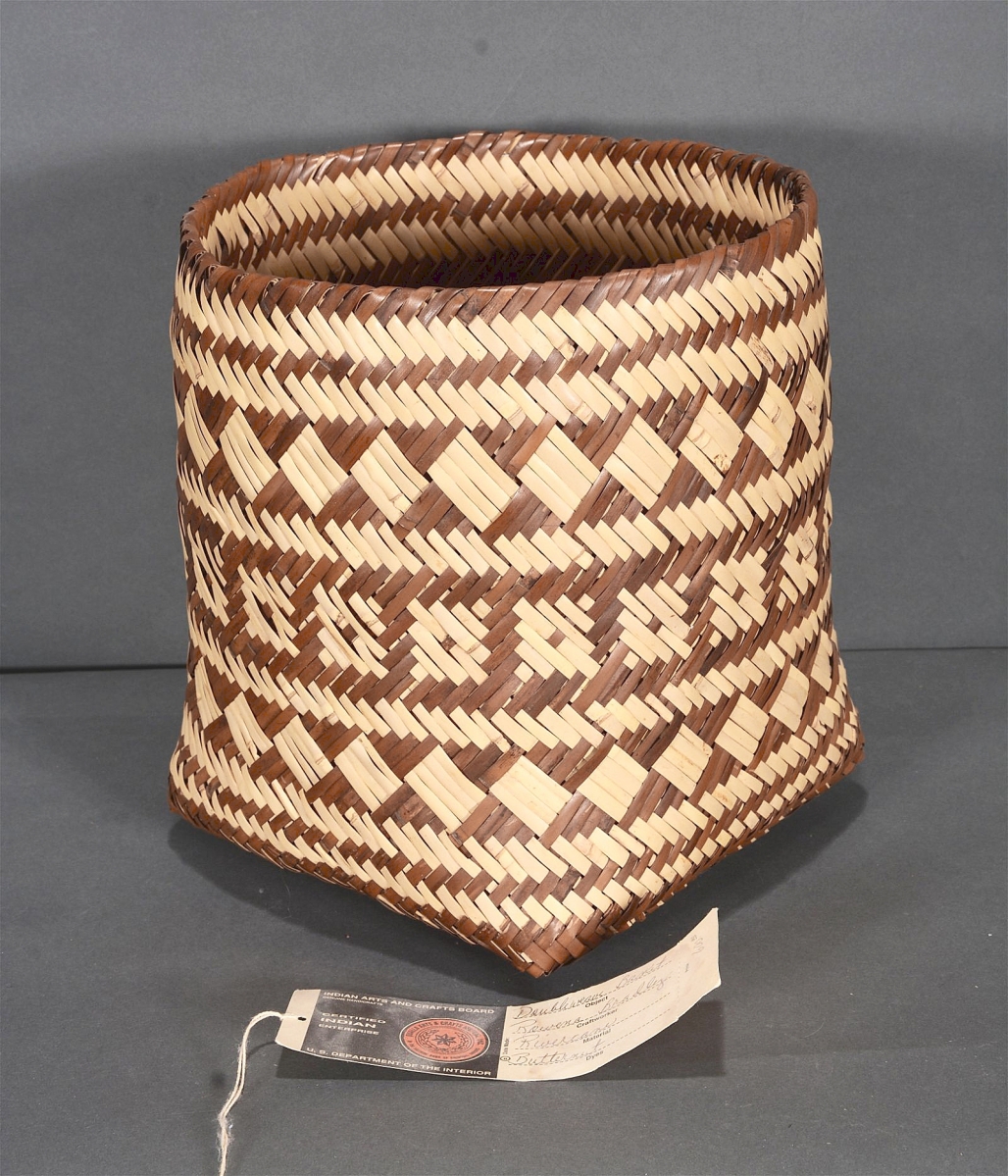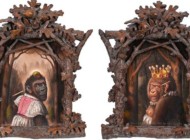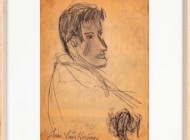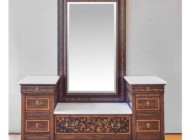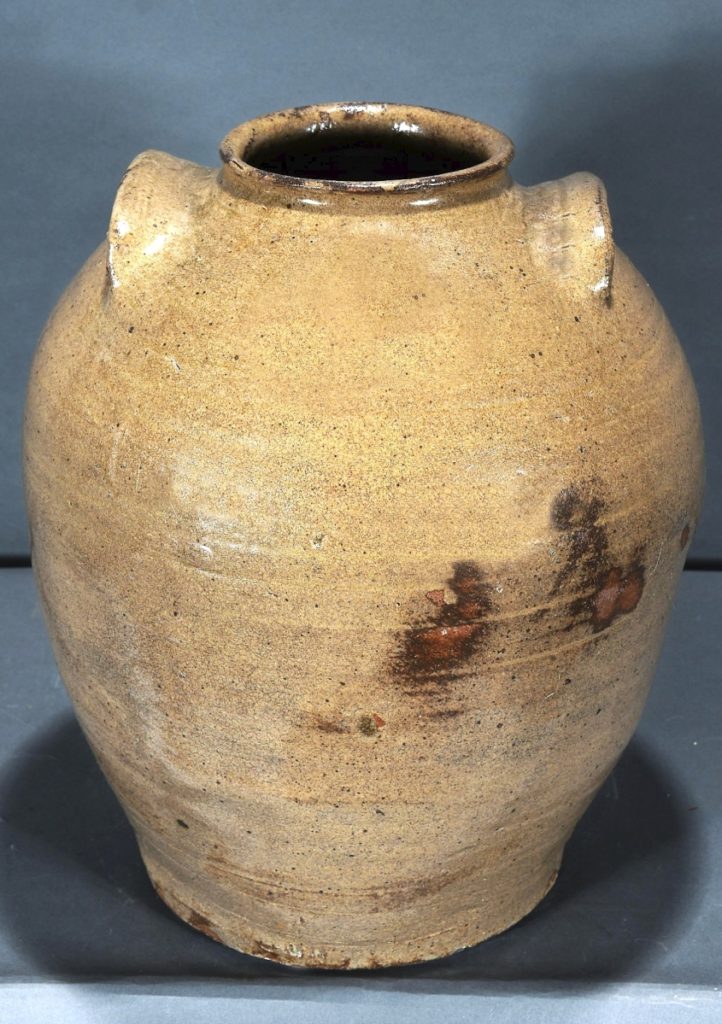
This ash-glazed stoneware 5-gallon noble jar, possibly slave-made, was the sale’s highest priced item. Realizing $8,750, it was made in the Edgefield district of South Carolina from locally dug clay.
By Rick Russack, Photos Courtesy Slotin Folk Art
BUFORD, GA. – Sales at Steve and Amy Slotin’s Slotin Folk Art auctions concentrate on the folk arts and crafts of the Southeastern United States. A primary focus is the pottery made in the region, from the slave-made pots of the 1850s or earlier to contemporary works. They are also deeply committed to the works of untrained, “outsider” folk artists as well as Native American art, much of which is Cherokee, produced in the same part of the country, along with African American and other quilts. Traditional pottery from New England and Pennsylvania is also included in their sales. Steve Slotin’s first auction was conducted in 1994 and his first cataloged sale took place in 1996. Before the sale, he commented, “I really want to show the richness and diversity of the arts of the Southeast. To me, the fascinating part is that so much is still being discovered or rediscovered. We never know what someone will bring in that’s been out-of-sight for the last 50 years. Much of this art was overlooked by the art world until the mid to late Twentieth Century. Interest has sky-rocketed since.” Slotin sales are unreserved, so all lots sold, meaning there could have been some very good buys. There was no in-house bidding for the February 11 and 12 sale but the internet and phones were busily employed throughout and absentee bids were processed.
In a new format, the first day of the sale was entirely devoted to pottery, with more than 450 lots, from the early and mid-Nineteenth Century ash and alkaline-glazed stonewares of the Edgefield district of South Carolina, to contemporary examples made in North and South Carolina and Georgia. Included were early examples by Thomas Chandler, Columbus Jackson Becham (a.k.a. CJB), Thomas Ritchie, Daniel Seagle and his son, James Franklin Seagle. Mid-Twentieth Century makers included Lanier Meaders, Michael and Melvin Crocker, Billy Ray Hussey and Clint Alderman, along with contemporary studio potters such as Ron Meyers. More than 125 face jugs were available.
The sale’s four highest priced pieces of pottery were each ash glazed stoneware dating to the Nineteenth Century. Bringing the highest price of the day at $8,750, was a 15-inch-tall 5-gallon jar by an unknown maker with an ash glaze from Pottersville, Edgefield. Pottersville is believed to be the earliest of Edgefield’s five major potteries. Prior to the Civil War, most potteries employed slave labor, and after emancipation, many former slaves remained in the area, working as potters. One pottery, that of Lewis Miles, employed 50 slaves, for tasks including digging clay, cutting wood as fuel for the kilns and delivering wares. All necessary raw materials were abundant in the region.
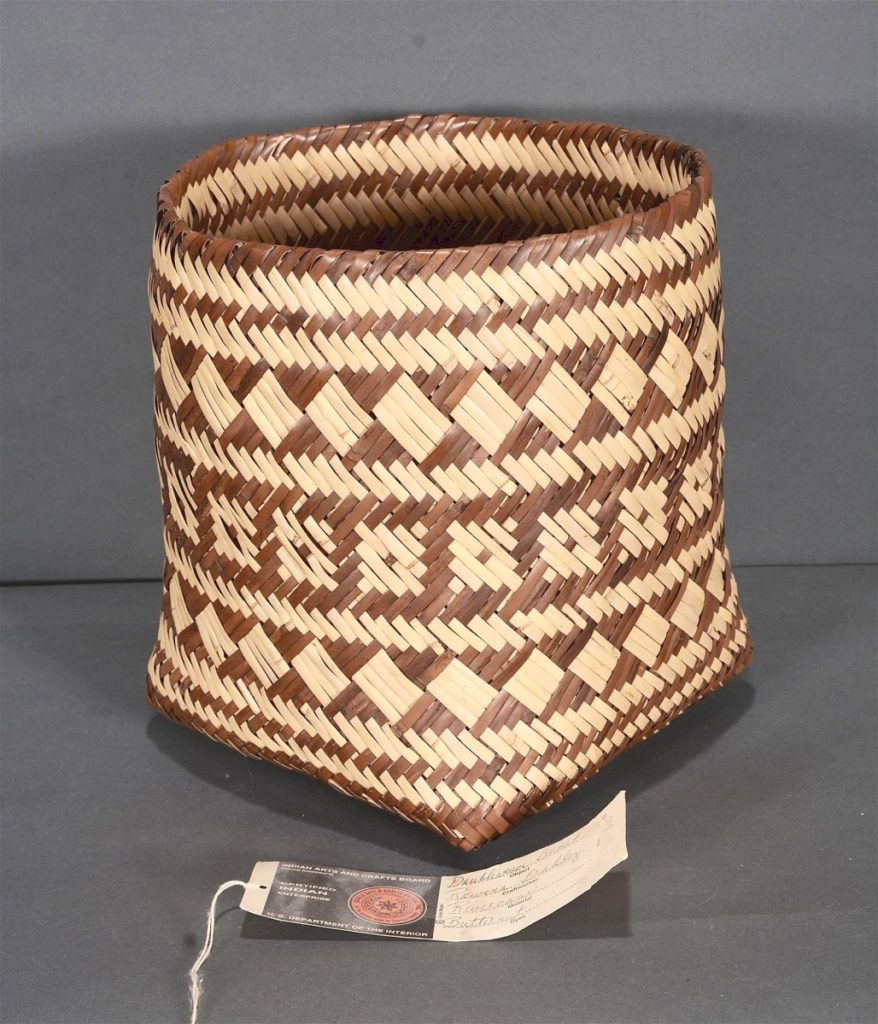
Rowena Bradley, a well-known contemporary Cherokee basket maker, made this 10-inch-tall double-weave basket, which went out for $1,375.
The second highest price of the sale was achieved by an ovoid jug, 13 inches tall, made by Isaac Lefevers and marked “IL” on the shoulder, which realized $7,500. Lefevers worked in Lincoln County, N.C. An early Edgefield 11-inch ash-glazed bowl, attributed to Thomas Chandler, circa 1840-1850, sold for $2,500. These are just a few of the many more examples.
Pottery from the Edgefield district will be the subject of a major exhibition opening this month. “Hear Me Now: The Black Potters of Old Edgefield, South Carolina,” which was recently on view at the Metropolitan Museum of Art and was the subject of the cover story of this publication’s September 16 issue, will be on display at Boston’s Museum of Fine Arts, from March 4 through July 9. It will focus on the work of Black potters in the Nineteenth Century American South, and will include about 60 pots from the Edgefield District, together with contemporary pots. The exhibition will include storage jars by the enslaved and literate potter and poet Dave Drake and face jugs by unrecorded makers
As mentioned, with 125 face jugs in the sale, there was a wide choice for buyers. The highest price, $2,000, was realized for a 5-gallon dripping glaze jug, more than 20 inches tall. It had been made and signed by Kim Ellington, a contemporary potter working in Vale, N.C. A pair of “experimental” face jugs with incised flowers and animals by Michael Ball, a contemporary potter from Asheville, N.C., each about 8 inches tall, sold for $1,625. Ball learned his trade from Kim Ellington, maker of the drippy glaze jug above. There were more than 20 face jugs made by Georgia potter Lanier Meaders and members of his family. Lanier died in 1998 and is considered by some to be a master of the form. His work has been exhibited at the Smithsonian and he was recognized with an award from the National Endowment For The Arts. The multigenerational Meaders family continues potting, making face jugs today along with numerous other potters. The variations are endless. Seven of Lanier Meaders’ face jugs finished within the top ten prices realized for face jugs. A 10-inch example, known as a “bowling ball” style, circa the mid-1980s, earned $1,125. It was signed, as is most of his work. Another example, a “cannon ball” jug, signed and dated 1988, sold for $1,063. Bringing the same price was a half-matte, half-high glaze face jug.
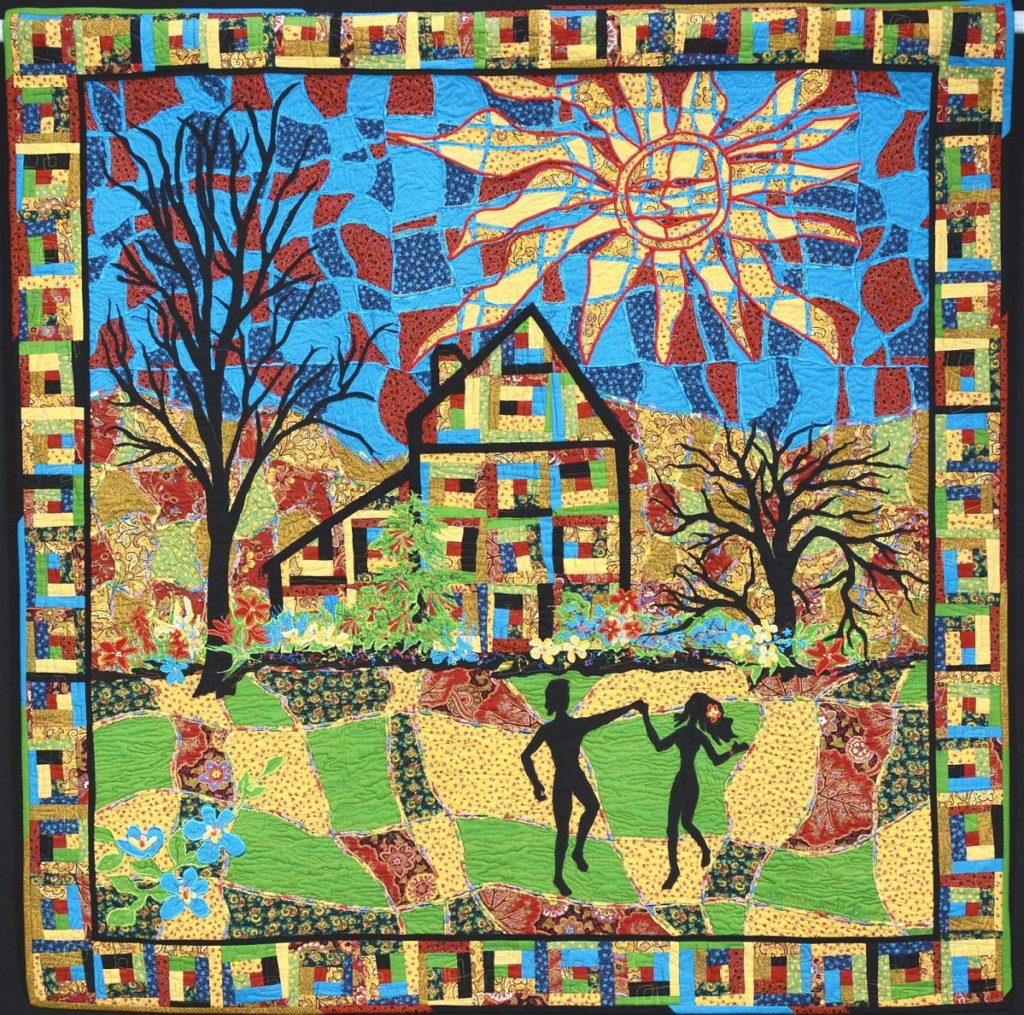
This imaginative quilt, “Day Dream World” by Karen Hull Sienk, signed and dated 2001, went out for a reasonable $282.
Other folk pottery included a selection of colorful folky animals, including some made by members of the Meaders family. A 16-inch rooster with a blue glaze by Edwin Meaders, signed and dated 1989, sold for $500 and his rooster of the same size, with a brownish-green glaze, sold for $750. A brown glazed hog with tusks and large spikes along its spine earned $375. It was made by Clete Meaders Jr, and was signed and dated 2002. Animal figures included brightly colored lions, goats, alligators, rabbits and more.
The second day of the sale included quilts and native American items, some vintage and some contemporary. There were more than 80 quilts, led by an ox-blood red block example selling for $2,625. Many of the quilts were from the Barbara Hacker Hunter Collection which was displayed in “Eyecatchers: The Hunter Collection” at The National Quilt Museum in Paducah, Ky., in 2008, and the Asheville Folk Art Center in 2014. A quilt in the “Holy Cross” pattern, possibly African American, reached $282. A very colorful quilt, titled “Day Dream World” by Karen Hull Sienk, signed and dated 2001, brought the same price. A creative quilt by Barbara Webster, “Blue Ridge Parkway In The Spring” signed, titled and dated 2002, sold for $250. Webster incorporates nature photographs into her quilts. This one included numerous photos along the parkway that runs through parts of Tennessee, Kentucky and West Virginia. Other textiles included a slave-made linen sheet; according to the catalog, it was made circa 1828 as a wedding gift for Lou Caldwell on the Gabriel Slaughter Caldwell plantation, Boyle Co. Ky. Its provenance included the Old Slave Mart Museum in Charleston, S.C.
Native American materials included ledger drawings along with vintage and contemporary baskets and pottery. Topping the offerings was a detailed 13-inch carved and painted figure of a dancer at a corn celebration by Hopi artist Ronald Hanyouti. It sold for $2,375. Seven ledger drawings appeared to be from one source. Each was colored pencil and graphite on ledger paper. A drawing of a mounted chief charging into battle, with arrows flying around him, sold for $1,188. Another, of a mounted chief hunting buffalo sold for $1,125 and a double-page drawing of a Native American encampment with tents, a fire, several Indians, a dog and more achieved $1,000. Steve Slotin said, “We were conservative with our descriptions of the ledger drawings. They came from one collection. They were on old paper and looked right but we decided to let buyers judge for themselves.”
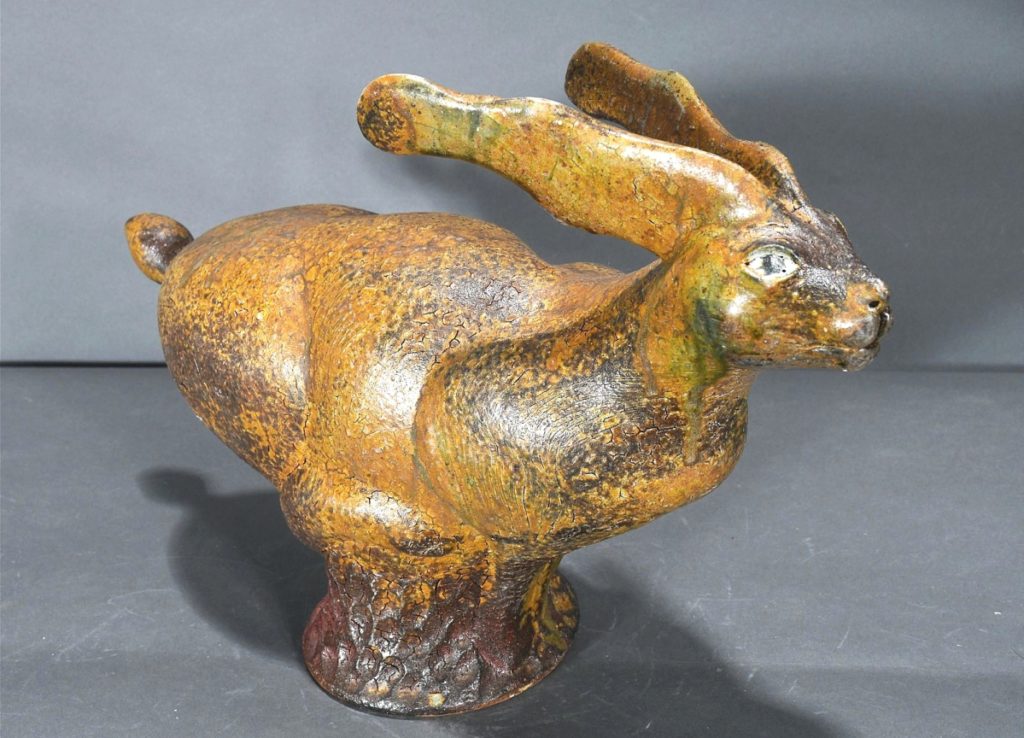
This large stoneware rabbit by an unidentified maker was 17 inches long; it was bid to $688.
Two decorated Hopi pots made by Rainy Naha were included with the large pottery offering. One, 6ý inches in diameter and referred to as a Partridge pot, sold for $1,625. The slightly larger other example, in a Lightning Bug pattern, earned $1,125. Naha, an award-winning potter, learned her art from her mother and her grandmother who was also a potter, as are her sister and brother. She works in the traditional hand-coiled manner and then shapes, sands and polishes her pots before painting with bee-weed (black) and native clay slips. There were numerous other pieces of contemporary pottery, such as a signed Laguna Pueblo flower decorated vase by Yvonne Lucas which earned $1,063 and a large owl charger by Hopi potter S. Setalla that brought $938. There were many more examples by a variety of makers.
The wide selection of more than 40 baskets included about 15 by Cherokee makers, such as baskets by Rowena Bradley, who is known as the Queen of the double-woven rivercane technique. Bradley dyed her creations with native roots and barks such as butternut, black walnut and bloodroot. A circa 1970s double weave basket by Bradley topped the basketry selection, finishing at $1,375 and another, attributed to her, sold for $1,188. A lidded picnic basket by Maidena Wildcatt, circa 1998, realized $1,000. It had won First Place in the 1998 Cherokee Indian Fair and its ribbon was included with the basket.
After the sale, Steve Slotin commented, “We were very happy with the sale. The Southern pottery, which we sold on the first day, did well and there were close to 600 people watching the sale online all day. Collectors for that are really dedicated and almost all of them know each other. It’s pretty much a regional market and most of that stayed in the South. We’re excited about the upcoming show at the Museum of Fine Arts in Boston and hope that show will attract additional interest in the material. The Native American material brought what we expected it would – most of it sold within our estimates. We had a really good selection of quilts, but that market is soft right now and there were some very good buys to be had. I think everyone was pleased.”
Prices quoted include the buyer’s premium. For more information, www.slotinfolkart.com or 770 532-1115.

